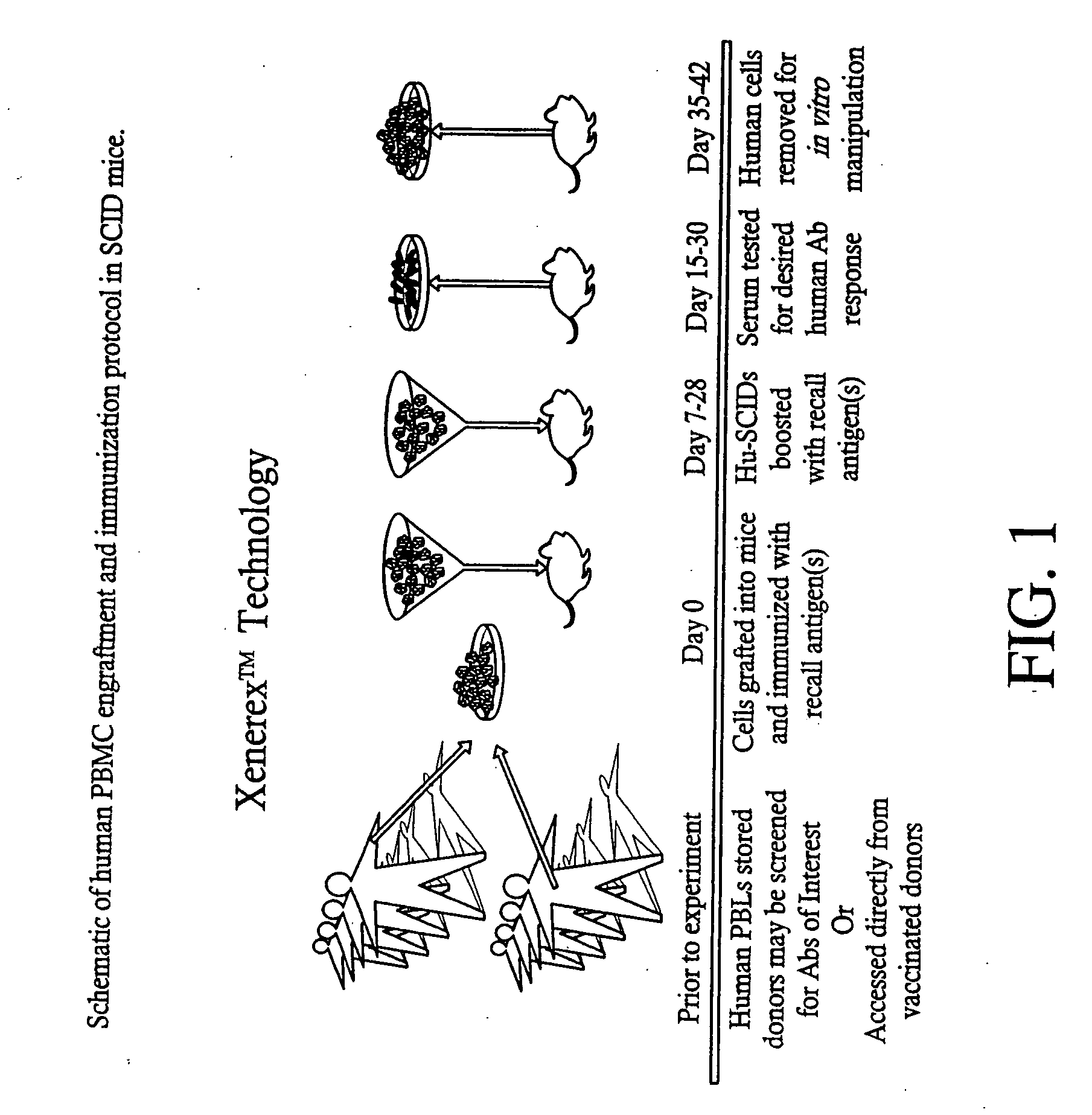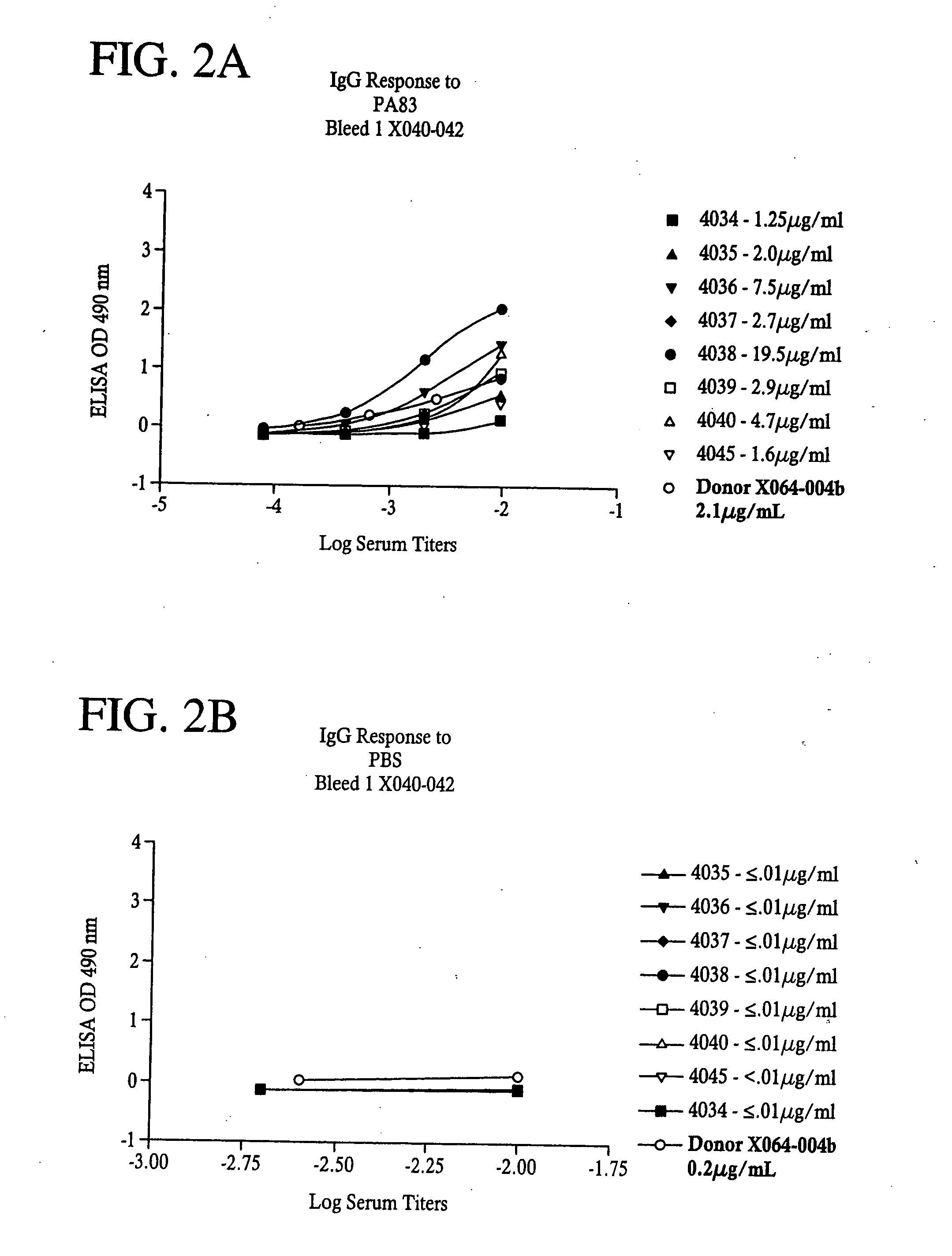Antibodies against protective antigen and methods of use for passive immunization and treatment of anthrax
an antigen and passive immunization technology, applied in the direction of antibacterial agents, peptides, antibody medical ingredients, etc., can solve the problems of sporadic reports describing the generation of useful monoclonal antibodies from such engrafted mice, and achieve the effects of reducing the severity of the illness, preventing the toxic effects of anthrax post-exposure, and being effectiv
- Summary
- Abstract
- Description
- Claims
- Application Information
AI Technical Summary
Benefits of technology
Problems solved by technology
Method used
Image
Examples
example 1
Indirect Elisa
[0099]Flat bottom microtiter plates (Nunc F96 Maxisorp) were coated with 50 ill of Bacillus anthracis Protective Antigen (PA) or Lethal Factor (LF)(List Biological Laboratories (Campbell, Calif.) at a concentration of 1 μg / mL in PBS overnight at 4° C. Plates were washed four times with PBS with Tween 20 at 0.1% and 50 μl of diluted sera was added to the wells for one hour at room temperature. Plates were washed as before and 50 μl of secondary antibody, HRP conjugated Goat anti-Human IgG, Fcy specific, or HRP conjugated Goat anti-Human IgM, Fc5μ specific, (Jackson ImmunoResearch, West Grove, Pa.) were added and incubated for one hour at room temperature. After another wash step, 100 μL of a substrate solution containing 0.4 mg / mL OPD (O-phenlenediamine dihydrochloride) in citrate buffer (0.025 M at pH 5.0) was added; after 15 minutes, 25 μl of 3N HCl was added to stop the reaction and plates were then read on a Microplate reader (VersaMax, Molecular Devices, Sunnyvale,...
example 2
RAW 264.7 Cell Line In Vitro Bioassay
[0100]The presence of neutralizing (protective) antibody to anthrax toxins PA and LF in the antisera were determined using an in vitro protection bioassay with the mouse macrophage RAW 264.7 target cell line. Hanna, P. et al., Microbiology 90:10198 (1993). PA (100 ng / ml) and LF (50 ng / ml) were pre-incubated with the indicated dilutions of antiserum for 30 minutes at 37° C. in a working volume of 100 μl of DMEM medium supplemented with 10% fetal calf serum, 2 mM L-glutamine, 100 IU / ml penicillin and 100 μg / ml streptomycin. This 100 μl volume was subsequently transferred into a 96 well flat bottom tissue culture plate containing 1×104 RAW 264.7 cells / well in 100 μl of the same medium. The culture was incubated for 3 hours at 37° C. The wells were washed twice with media. The residual attached cells were lysed and the released Lactate dehydrogenase (LDH) levels were measured using a CytoTox 96 kit (Promega, Madison, Wis.). Briefly, 10 μl Lysis Solut...
example 3
Engraftment of SCID Mice with Human PBMC from Anthrax-Vaccinated Donors
[0101]Peripheral blood mononuclear cells were enriched from whole blood of anthrax-vaccinated donors by density gradient centrifugation using Histopaque, 1077-1 (Sigma, St. Louis, Mo.). One of skill in the art will understand that other types of cells can also be used in accordance with several embodiments of the present invention. Typically, one unit of blood from donors was obtained. Female SCID / bg 12 week old mice were each engrafted (via i.p. inoculation) with 2.5×107 isolated human PBMC. They were treated concomitantly i.p. with a volume of conditioned medium from the OKT8 mouse hybridoma grown in Ex-cell 620 hybridoma serum free medium (JRH, KS) and 2 mM L-glutamine which contained 0.2 mg of the anti-CD8 antibody (used directly without further purification). The mice were immunized with a combination of PA and LF (i.p.) 2 μg each adsorbed to Alum (Imject®, Pierce, Rockford, Ill.) and subsequently boosted (i...
PUM
| Property | Measurement | Unit |
|---|---|---|
| molecular weight | aaaaa | aaaaa |
| molecular weight | aaaaa | aaaaa |
| temperature | aaaaa | aaaaa |
Abstract
Description
Claims
Application Information
 Login to View More
Login to View More - R&D
- Intellectual Property
- Life Sciences
- Materials
- Tech Scout
- Unparalleled Data Quality
- Higher Quality Content
- 60% Fewer Hallucinations
Browse by: Latest US Patents, China's latest patents, Technical Efficacy Thesaurus, Application Domain, Technology Topic, Popular Technical Reports.
© 2025 PatSnap. All rights reserved.Legal|Privacy policy|Modern Slavery Act Transparency Statement|Sitemap|About US| Contact US: help@patsnap.com



